Fry me kangaroo brown, sport
Skippy could be on more menus following a report that expanding the kangaroo industry would significantly cut greenhouse gases.
Skippy could be on more menus following a report that expanding the kangaroo industry would significantly cut greenhouse gases.

Skippy could be on more menus following a report that expanding the kangaroo industry would significantly cut greenhouse gases.
A paper in the journal Conservation Letters says reducing cattle and sheep populations and increasing the kangaroo numbers to 175 million by 2020 would lower greenhouse gas emissions by 16 megatonnes, or 3 percent of Australia's total emissions.
The paper's lead author, George Wilson, says a proposal to reduce sheep and cattle numbers on the rangelands by 30 percent should be considered.
Dr Wilson is involved with UNSW's Future of Australia's Threatened Ecosystems (FATE) project and also runs the consultancy company Australian Wildlife Services.
"Sheep and cattle constitute 11 per cent of Australia's total greenhouse gas emissions," says Wilson. "Kangaroos, however, produce relatively little methane because they are not ruminants."
UNSW Science Dean, Mike Archer, a long time advocate for sustainably farming Australian bush tucker, believes that kangaroo can be promoted as a means of increasing our health, wealth and happiness.
"Eating more kangaroo has an incredible array of benefits, for our environment, for dietary health and as a tasty red meat," he says. "The soft padded feet of kangaroos are far kinder to the land than the hooves of sheep and cattle, which have caused untold damage and consequent land erosion."
Kangaroos emit one-third as much methane as ruminant animals, such as cattle, sheep and goats, which are responsible for 60 percent of global methane emissions. Like carbon dioxide, methane is a greenhouse gas that is a real contributor to global warming and climate change.
For more on this story visit the Faculty of Science website.
Media contacts: Peter Ampt | 0421 998 886 or Dan Gaffney | 0411 156 015 | d.gaffney@unsw.edu.au